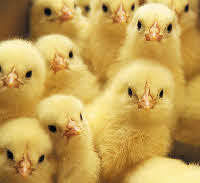



Wet Baskets Can Impair Chick Quality
THE NETHERLANDS - Chick transfers should always be made into dry baskets, says 'Tiny' Barten of Pas Reform.During a recent trip to the tropics, Martin 'Tiny' Barten, senior hatchery specialist at Pas Reform, had the chance unexpectedly to visit a hatchery that was due to host a Pas Reform Academy Seminar. He writes that his unplanned visit was well received, giving the hatchery manager the chance to talk to him about chick quality, which was not entirely satisfactory. Culled chicks and first week mortality were slightly high by their standards.
Four hatch days each week meant that Mr Barten could witness chick take-off during his visit. The newly hatched chicks presented with full bellies – and too many unclosed navels. Other signs confirmed that 502-504 hours of incubation were not enough: the chicks were being pulled too early. At the end of the short visit, they agreed that relative humidity set points would be reduced from 53 to 50 per cent, with incubation starting four to six hours earlier.

A month later, as the hatchery welcomed delegates from all over the region to the Academy seminar, the company's General Manager asked if Mr Barten would join him and his team in the evenings. It seemed that while there had been some improvements in chick quality since the previous visit, results were still not quite as they should be.
During the day, all participants were fully occupied with the Seminar programme, taking part in practical sessions, attending presentations and enjoying lively discussion.
In the evenings, Mr Barten joined the hatchery manager and his team and together, they reviewed all the hatchery data.
When they looked at the climate histories for the hatches pulled earlier that week, a pattern started to emerge. For each cycle, relative humidity immediately after transfer was very high, gradually decreasing to set point then rising again sharply with the emergence of the chicks.
When asked if the hatcher baskets were always 100 per cent dry at transfer, there was a lengthy discussion before agreeing on their reply: "On Monday they are..." Mr Barten concluded that the baskets were not, therefore, completely dry on the other hatch days.
When it was also confirmed that chick quality was indeed usually much better on a Thursday, the solution was clear. Evaporating water from wet baskets was reducing the temperature and increasing humidity in the hatcher, resulting in chicks with thick bellies and poor navels.
It was agreed that an extra set of hatcher baskets would quickly pay for themselves. And to maintain good chick quality in the future, a golden rule would be applied: transfers would always be made in dry baskets!








